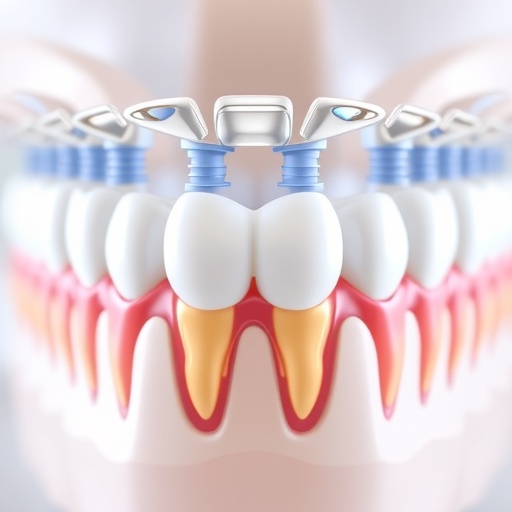Recent advancements in the fields of tissue engineering and regenerative medicine have heralded a new era in dental care, particularly through the development of bioengineered teeth. A groundbreaking study by I. Angelopoulos explores the myriad applications of stem cell technologies and tissue engineering approaches in the fabrication of artificial teeth, an innovation that could significantly alter dental treatments and improve outcomes for patients who have lost their natural teeth due to injury, disease, or decay. This revolutionary research positions itself at the intersection of biology, technology, and patient care, making it a pivotal topic for ongoing scientific discussions.
The journey into the world of bioengineering teeth begins with the fundamental understanding of the structural and functional complexities of natural teeth. Teeth are not merely hard structures; they comprise various tissues, including enamel, dentin, cementum, and pulp, each contributing to the overall function of the tooth. When developing bioengineered teeth, replicating these components with precision is crucial for ensuring functionality and integration within the oral environment. This study highlights the significance of mimicking the intricate architecture of natural teeth to achieve successful outcomes in dental regeneration.
One of the most compelling aspects of this research is its exploration of stem cell applications. Stem cells have garnered significant attention in recent years for their remarkable ability to differentiate into various cell types, making them pivotal in regenerative medicine. The article emphasizes how mesenchymal stem cells, which can be harvested from various tissues such as bone marrow or dental pulp, are instrumental in promoting the regeneration of dentin and pulp tissues. Such capabilities allow for the creation of bioengineered teeth that are not only structurally similar to natural teeth but are also equipped with the regenerative prospects necessary for their long-term health.
Moreover, the study delves into the advanced biomaterials currently being utilized in the development of bioengineered teeth. Traditional materials have often fallen short in mimicking the biological properties of natural tooth structures. However, advancements in materials science have introduced ceramics, polymers, and composites that offer enhanced biocompatibility, mechanical strength, and aesthetic qualities. The careful selection of these materials can lead to greater success rates in tooth regeneration and longevity when implanted in patients.
The integration of 3D printing technology also plays a prominent role in the bioengineering of teeth. The ability to create complex geometries and structures via 3D printing allows for the fabrication of tooth models that mimic natural teeth closely. This technology not only accelerates the production process but also enables customization based on individual patient needs, presenting a significant advancement over traditional dental prosthetics. As this technology evolves, it holds the potential to revolutionize the way dental restorations and implants are produced and implemented.
In addition to focusing on structural elements and materials, the research underscores the importance of the biological environment surrounding the bioengineered tooth. Successful integration into the oral cavity requires a favorable interaction with the host’s periodontal tissues. The article discusses novel strategies to promote vascularization and innervation in bioengineered teeth, which are critical for their survival and functionality. These strategies may involve the incorporation of growth factors or engineering the tooth structures to encourage the growth of blood vessels and nerves.
Furthermore, Angelopoulos’s findings highlight the significant potential of using bioengineered teeth to address not just functional deficits but also aesthetic concerns. For many patients, losing a tooth impacts not only their ability to chew but also their self-esteem and confidence. By creating bioengineered teeth that mimic the appearance and function of natural teeth, clinicians can provide patients with solutions that restore both their dental health and psychosocial wellbeing.
Despite the promising prospects of bioengineered teeth, the research acknowledges the challenges that remain. Regulatory hurdles, ethical considerations, and public acceptance pose significant barriers to the widespread adoption of these advanced therapies. Addressing safety, efficacy, and patient perspectives is crucial to ensuring that bioengineered teeth progress from experimental phases to practical applications in clinical dentistry.
The future of dental care is poised for a transformative shift, as innovations from this study pave the way for comprehensive regenerative strategies in oral health. As research into bioengineered teeth continues to develop, it is essential to maintain a collaborative approach, engaging researchers, clinicians, bioengineers, and patients alike to build a holistic understanding of what constitutes effective dental regeneration.
In conclusion, the field of bioengineered teeth and regenerative dentistry represents a fascinating area of ongoing research, promising to reshape the future of how dental care is approached. With advancements in tissue engineering, stem cell applications, and 3D printing technologies, there is hope that bioengineered teeth will not only serve as a practical solution for tooth loss but will also enhance overall quality of life for individuals worldwide. As we anticipate further breakthroughs in this arena, one thing remains clear: the future of dentistry is bright, and bioengineered teeth may soon become a commonplace reality in clinical practice.
Subject of Research: Bioengineered Teeth and Regenerative Strategies
Article Title: Bioengineered Teeth and Regenerative Strategies: Advances in Tissue Engineering and Stem Cell Applications
Article References:
Angelopoulos, I. Bioengineered Teeth and Regenerative Strategies: Advances in Tissue Engineering and Stem Cell Applications.
Ann Biomed Eng (2025). https://doi.org/10.1007/s10439-025-03907-8
Image Credits: AI Generated
DOI: https://doi.org/10.1007/s10439-025-03907-8
Keywords: Bioengineering, Dental Regeneration, Stem Cells, Tissue Engineering, 3D Printing, Biomaterials, Dental Care, Regenerative Medicine.




